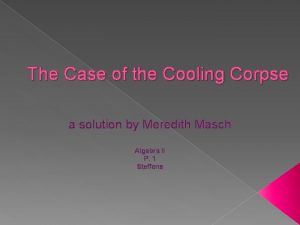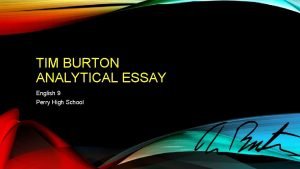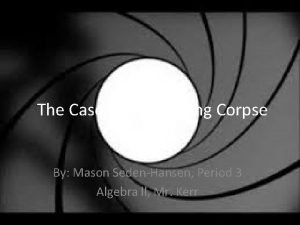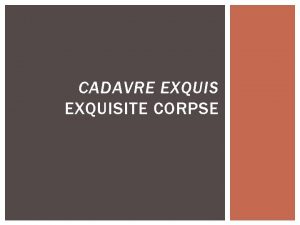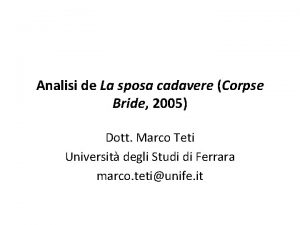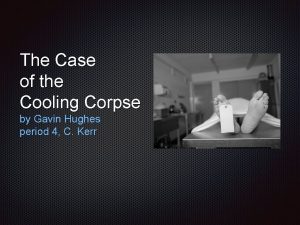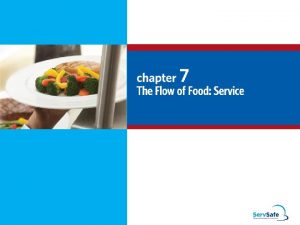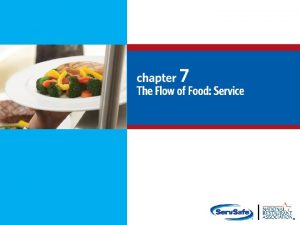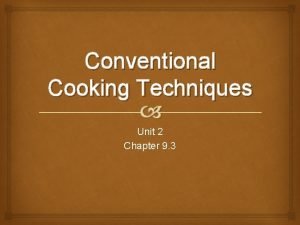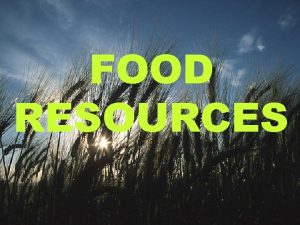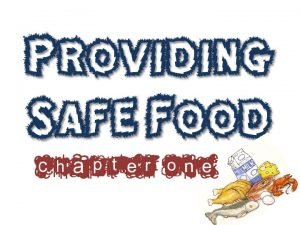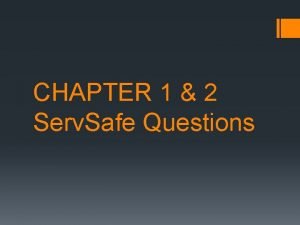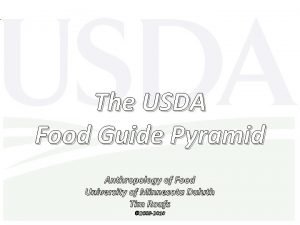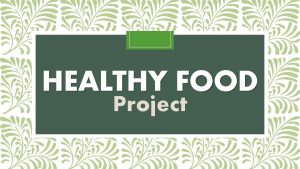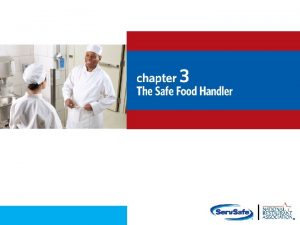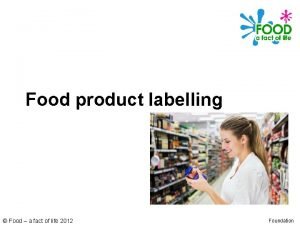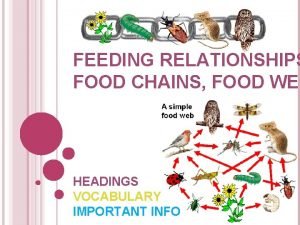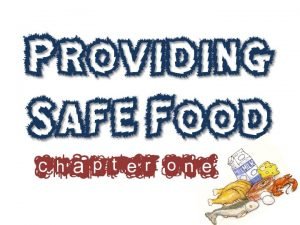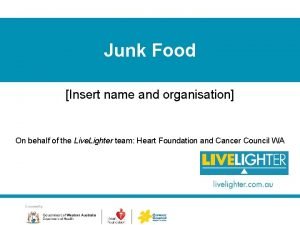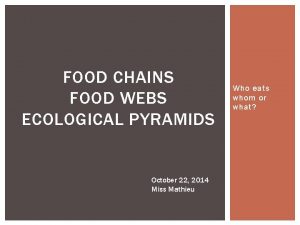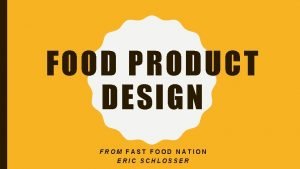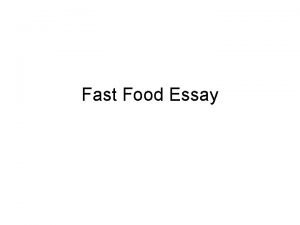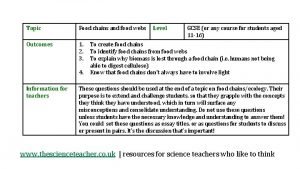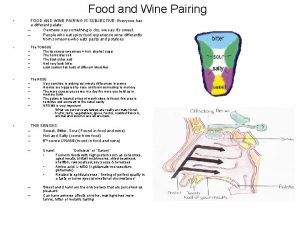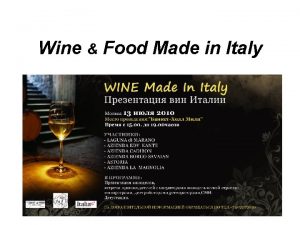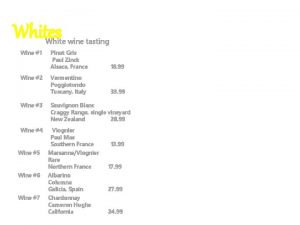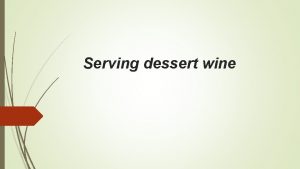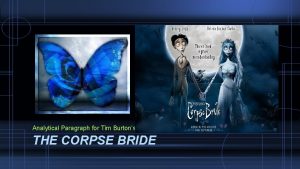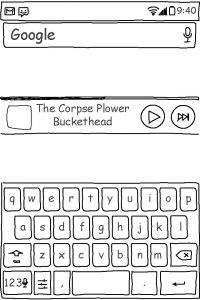Food without wine is a corpse wine without













































- Slides: 45

“Food without wine is a corpse; wine without food is a ghost; united and well matched they are as body and soul, living partners. ” Andre Simon (1877 -1970)

Welcome Introduction to Food and Wine Pairing

Intro to Food & Wine Pairing ¢ Course Objective: Learn the basic elements of the character and key components of wines. l Includes the five primary taste sensations present in everyday food (salty, sour, sweet, bitter and savory) and how these affect the taste of wine l

Course Overview WEEK 1: WEEK 2: WEEK 3: WEEK 4: WEEK 5: WEEK 6: WEEK 7: WEEK 8: Wine Tasting Primer: introduction to Classical Pairings - Cuisine & Terroir Sour (Acidity), Paper Assignment Sweet (sugar) Desserts Tannin (Bitter) Weight and Body Oak and Spice Umami FINAL EXAM

What is Food & Wine Pairing? Food and Wine Pairing is the balancing and enhancing of both the dish and the wine whereby both are greater than the sum by mutually being lifted into excellence.

Theoretical VS. Empirical Theoretical ¢ ¢ “White with Fish, red with steak. ” Matching Traditions l ¢ Champagne and caviar Gastronomic Identity Empirical ¢ ¢ Empiricism means, roughly, "try it and see". It is a theory of knowledge that is practical rather than abstract, and asserts that knowledge arises from experience

Theoretical ¢ Food and Wine Pairing Mechanics l l Matching Traditions Component Matching • Sweet, sour, bitter… l l Flavor theory- “Spices” Association theory – “bridges”

Empirical Evaluation of Wine Visual Observation: color, clarity, hue, density ¢ Olfactory Qualities: nose, bouquet ¢ Taste Qualities: sweetness, fruitiness, acidity, bitterness, tannic, thin, heavy, finish, etc. ¢ Overall Impressions: general qualities, balance ¢

Empirical Evaluation of Food Eye appeal and color combination ¢ Aromatic character and perfumes ¢ Sweetness, saltiness, acidity, lean, fat, texture ¢ Overall impressions ¢

A Wine Tasting Primer Wine Tasting is: Sensory Analysis - Theory and Practice of Sensory Evaluation

Definition of Sensory Analysis - A scientific discipline used to induce, quantify, analyze and assess the responses to products based on sight, smell, taste, touch, and hearing.

Sensory Evaluation Sensation (noun) 1. 2. An organism’s immediate neurological response to a stimulus in the environment The capacity to receive impressions through the sense organs

Sensory Evaluation Perception (noun) 1. 2. The interpretation of information gathered by the senses The ability to notice or discern things in the environment that escape most people

The Physical Process Sensation = unconscious reflexive Perception = Conscious stimulus>receptor>impulse>brain>evaluation

The Physical Process Stimulus = wine Ø Receptor = Retro nasal Ø Impulse = electric charge Ø Brain = squishy stuff Ø Evaluation = appraisal Ø

The Senses Sight ¢ Smell ¢ Taste ¢ Touch ¢ Hearing ¢

To effectively evaluate the wine, it is important that the tasting environment be as neutral as possible. The taster as well, must be as neutral as possible. l l No Perfumes, Scented Hairspray or Aftershave Possess a Clean Palate • No strong foods prior to tasting. • The effects of smoking can interfere with your ability to accurately assess flavors. • Alcohol consumption clouds senses. To maintain objectivity it is important to SPIT!

Tasting Equipment ¢ GLASSWARE A tulip shaped glass large enough to hold a tasting of wine (generally 1 - 1½ ounces) with plenty of space above it. l A stem is preferable so that the glass may be held without affecting temperature and for assessment of color. l A tasting notebook or tasting sheet on which to make notes for future reference and evaluation. l

Opening and Pouring Wine ¢ ¢ ¢ 1) Present bottle with the label facing the host. 2) Place bottle on the table and remove the capsule. 3) Insert the corkscrew and remove the cork. 4) Tradition requires that the host is shown the cork. Just place it on the table next to the host’s wine glass. 5) To finish, wipe off the lip of the bottle with a clean and professionally folded cloth napkin.

Pouring Etiquette ¢ ¢ 1) To pour, stand behind the person to her or his right with bottle label facing left. 2) Hold the lip of the wine bottle just above and offcenter of the wine glass. l ¢ 3) Finish the process by giving the bottle a twist. l ¢ Tilt the bottle to pour a stream of wine into the glass (pour about an ounce in the host’s glass for approval). Tilt it toward you before taking it away to minimize any drips. Service order: first is the most senior lady at the table, then, the other ladies are served, followed by the men, and finally the host.

General Wine Service ¢ ¢ ¢ Psychological components: etiquette, customs, traditions, and fashion. To make guests feel comfortable and special. To provide education, knowledge and friendly service. Modern sommeliers are less intimidating. Key service elements: ensuring timeliness, at the right temperature, service is smooth, unobtrusive, and professional.

The Wines In preparation of wine tasting or service, consider the following: ¢ The Temperature of the Wine l White wines and Rosé should be served chilled. l Red wines should be served at room temperature. • See Table 2. 1 in Harrington

Tasting Order ¢ The Order of the Wine Tasted l Whites before Reds l Young before Old l Dry before Sweet l Sweet Fortified Wines served last

The 6 -Ss of Wine Evaluation ¢ ¢ ¢ Seeing Swirling Smelling Sipping Spitting/Swallowing Savoring

Sight ¢ Look l What is the wines appearance Clarity l Is the wine clear? Cloudiness in a wine can be one of the first signs that the wine is faulty. If so, these will be confirmed on the nose or palate. ¢ Color and Intensity ¢ To assess color tip glass away from you at a 45° angle, over a plain white background • Color – Be as descriptive as possible • Pink →Dark Purple →Brick for Red Wines • Pale Straw →Deep Gold for White Wines

Sight Color is an indicator of Age l l White/Rosé/Sparkling wines darken with age Whites Clear, silver, straw, yellow, gold, copper, caramel, brown Rosés blush, pink, salmon, orange, copper, garnet, caramel, brown Reds Purple, ruby red, garnet, rust, amber, caramel, brown • Red Wines lighten with age

Smell The nose can tire quickly ¢ Short sniffs are best ¢ ¢ Swirling First smell wine before swirling l Then swirl, releasing aromatics in wine l Initially think of aromas in terms of Fruit, Earth and Wood l

Smell First things first … l Condition • Is the wine Clean? • Various reasons: • Acension • SO 2 (Sulfur Dioxide) • Oxidation • TCA

Smell o Aroma – The Most Important Factor o o Intensity: The amount of lift from the glass Concentration: Strength of aroma. Expression: Distinctiveness of character. Complexity: A diversity of harmonious smell sensations. o Cleanliness: Absence of winemaking faults


The Wine Aroma Wheel

Smell ¢ Development l Aroma vs. Bouquet • Aroma – generally pertaining to young wines and are derived directly from the fruit itself, “fruit driven” • Bouquet – smells which have developed as a result of ageing, in particular bottle ageing (leather, earth, cigar box) ¢ Fruit Character • Highly personal interpretation • Smells and tastes can be described in a number of ways: Fruity, Floral, Vegetal, Spicy, Woody, etc. • Aroma Wheel

Sip tasting is used to confirm impressions already made by the nose and add final essential details. ¢ SWEETNESS l Sweet or Dry or somewhere in between? ¢ ACIDITY l Observed by a watering sensation in mouth. Generally evaluated as Low, Medium or High. TANNIN l Detected by a drying effect on the gums ¢ ¢ FRUIT CHARACTER AND INTENSITY l Should first confirm those already noted on the nose in the wine.

Taste ¢ The Aesthetic Palate l l l Intensity: The amount of flavor activity in the mouth. Concentration: The strength of flavor Complexity: Diversity of complementary flavors. Measured by how long a wine holds your interest Balance: A wine is in balance when no one character dominates your psyche Structure: An amalgam of balance and timing of the appearance of sensory characters to produce a wine that is seamless.

Taste ALCOHOL l Can be difficult to assess unless very high or very low. Individual tolerance varies. l l l Adds to our perception of weight in a wine Alcohol adds to our perception of sweetness in wine. A higher alcohol content can also alter our perception of acidity in a wine.

Taste ¢ LENGTH l Known as the period of time that the wine’s flavors remain on the palate after the wine has been spat out. l ¢ Long length, if pleasant, is generally considered to be an indication of quality. CONCLUSION l The overall impression of the wine. The “harmony” of the wine is a direct reflection of the wine’s balance.

Touch l Mouth Feel • Body: The weight displayed in the mouth. An amalgam of viscosity and concentration • Astringency: Drying, roughing and puckering sensations derived from tannins. • Other Texture: Includes alcoholic warmth, creaminess.

Hearing ¢ Discourse In sensory Evaluation an important factor in Potato Chips l For this course listening is important as a mechanism in learning l Taste commentaries l

The Tasting Method: A Review 1. Look: Always observe the appearance of the wine. It can tell you a great deal about what is likely to come. 2. Swirl: Assists in releasing volatiles. 3. Sniff: Don't be shy. Sniff hard and confidently 4. Taste: Take approximately a half a mouthful of wine into your mouth. 5. Weigh: Holding the wine in your mouth, consider the weight of the wine. 6. Aerate: Tipping head slightly forward, purse lips and draw air into mouth and over wine. 7. Distribute: Gently swish the wine in your mouth making sure it comes in contact with all parts including gums. 8. Expectorate: Pick up your spit cup and discharge the contents of your mouth into the cup. 9. Take a moment to reflect and then note your tasting observations.

How to Improve Your Sensory Capacity 1. 2. 3. 4. 5. Add structure to odors- be specific Practice – Yes, Practice Have a system – take notes Develop more awareness of odors Take time – stop and smell the rosé

Pitfalls ¢ Physiological factors Adaptation l Thresholds l • Genetic and biological l Anosmia • Odor blindness • 35% of Americans (Androsterone) l Ageing

Taste Modifiers l Taste Modifiers • Gymnema Sylvestre • The Orange Juice Effect l l l l Serving Temperature Pregnancy Allergies Smoking Tasting order Palate Fatigue Psychological Factors • Irrelevant Criteria

Psychological and Physiological Factors include: ¢ Taster’s personality & external elements ¢ Personal Biases ¢ Preconceived notions of a particular winemaker, type of wine, or region. ¢ The methods used in sensory analysis are strictly controlled to maintain proper temperature, lighting and to minimize off-odors. ¢ Blind tasting attempts to negate biases about price and prestige.

The Sideways Effect Miles Raymond: . . . Let me show you how this is done. First thing, hold the glass up and examine the wine against the light. You're looking for color and clarity. Just, get a sense of it. OK? Uhh, thick? Thin? Watery? Syrupy? OK? Alright. Now, tip it. What you're doing here is checking for color density as it thins out towards the rim. Uhh, that's gonna tell you how old it is, among other things. It's usually more important with reds. OK? Now, stick your nose in it. Don't be shy, really get your nose in there. Mmm. . . a little citrus. . . maybe some strawberry. . . [smacks lips] Miles Raymond: . . . passion fruit. . . [puts hand up to ear] Miles Raymond: . . . and, oh, there's just like the faintest soupçon of like asparagus and just a flutter of a, like a, nutty Edam cheese. . . Jack: Wow. Strawberries, yeah! Strawberries. Not the cheese. . .

The Tabasco Test ¢ How Piquant is it? On a scale of 1 to 5 l 1 = not hot at all l 5 = being extremely l
 Corpse wax
Corpse wax Who killed dr dedman
Who killed dr dedman Corpse bride analysis essay
Corpse bride analysis essay The case of the cooling corpse
The case of the cooling corpse Exquisite corpse dali
Exquisite corpse dali La sposa cadavere cast
La sposa cadavere cast The case of the cooling corpse
The case of the cooling corpse Vultures chinua achebe
Vultures chinua achebe Structural adaptation in plants
Structural adaptation in plants Corpse bride storyboard
Corpse bride storyboard Food chain food chain food chain
Food chain food chain food chain Unit 2 food food food
Unit 2 food food food Alliteration in keeping quiet
Alliteration in keeping quiet Without title poem by diane glancy
Without title poem by diane glancy Without title poem by diane glancy
Without title poem by diane glancy Basic cooking methods
Basic cooking methods Holding hot food without temperature control
Holding hot food without temperature control Jesus was a cool dude song
Jesus was a cool dude song Cold holding
Cold holding Chapter 9 principles of cooking
Chapter 9 principles of cooking Explore food a fact of life
Explore food a fact of life Food web vs food chain
Food web vs food chain Food resources world food problems
Food resources world food problems Food chains food webs and energy pyramid worksheet
Food chains food webs and energy pyramid worksheet Food webs with decomposers
Food webs with decomposers Food chain of an owl
Food chain of an owl Importance of food
Importance of food Which is a tcs food bread flour sprouts strawberries
Which is a tcs food bread flour sprouts strawberries Of junk food
Of junk food Piramid makanan
Piramid makanan Junk food vs healthy food project
Junk food vs healthy food project Food handlers can contaminate food when they
Food handlers can contaminate food when they Food a fact of life food labelling
Food a fact of life food labelling Desert ecosystem food web
Desert ecosystem food web 4 food chains
4 food chains Food chain and food web
Food chain and food web Tcs food
Tcs food Junk food
Junk food Healthy junk restaurant
Healthy junk restaurant Food chains, food webs and ecological pyramids
Food chains, food webs and ecological pyramids Food product design by eric schlosser
Food product design by eric schlosser Fast food introduction
Fast food introduction How many food chains are there in the food web
How many food chains are there in the food web Difference between food chain and food web
Difference between food chain and food web A little food or a few food
A little food or a few food Food safety food security
Food safety food security

